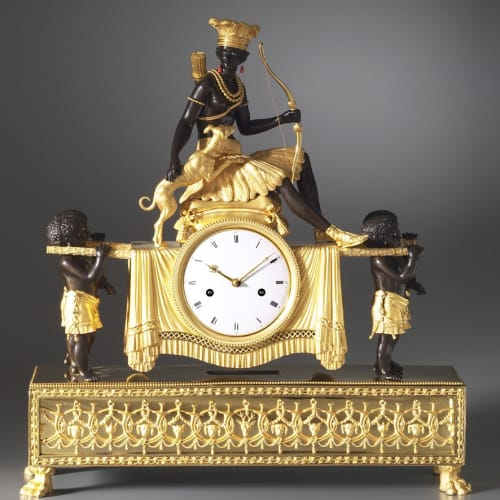The exact date of when Deverberie became a maître bronzier is unrecorded, we know that he was working as a caster in 1788 and that he married Marie Louise Verron but they had no children. An article by Charlotte Vignon from Cleveland Museum of Art notes that he may have been the same Deverberie who specialised as a watchcase maker and that after the abolition of the guilds in 1791, he opened a bronze casting and clock factory with Jean George Hertzog. Having been established at rue Barbet, Deverberie then moved to rue des Fossés du Temple where he ran the firm of Deverberie et Cie. The lifting of the guild regulations during the French Revolution allowed casters, who during the ancient règime were strictly limited to working in bronze, to now develop factories of their own. Deverberie was one such man who took advantage of this freedom so that now all stages of the bronze making process, from casting, gilding, assembly and retail could occur in one workshop. In this he proved highly successful since by 1803 his business was worth 104,000 francs.
Deverberie et Cie made a range of luxury bronze objects from chenets and fire grates to candelabra and chandeliers. However, clock cases were the firm’s speciality. A large variety of clockmakers supplied the movements including the Imperial clockmakers Henri Lepaute and Lépine as well as Lemoine, Marc Sandoz and Dubuc (Dubucq). At times Deverberie contracted part of the gilding to Jean Claude Herouard, Jean-Jacques Dubois and others and also bought in glass globe covers for his clock cases from the famous glass blower Jean-Baptiste Binet as well as marble from Gilles l’ainé. In contrast to a number of other major bronziers, Deverberie did not supply the Garde-Meuble direct though he may have done so through as intermediary. Rather he tended to supply private clientele and also sold his cases elsewhere in Europe, hence one has the name of Christophe Noseda à Marsailles on the dial; another pendule d’Amèrique features the name of Aubineau of Strasbourg while here the dial is signed Mottet Crétien à Troyes, whose name is also spelled Mottet Chrétian à Paris on other figural clocks. Other Deverberie cases were sent to Brest or further afield to Moscow and for the Turkish export market. Deverberie was also keen to exhibit his bronzes throughout Europe. For instance, in 1802 he sent goods worth 40,000 francs to the Leipzig fair – a move that may have been suggested by his fellow bronzier Jean-André Reiche who had originated from Leipzig and like Deverberie was the main and finest maker of pendules au Nègre.
